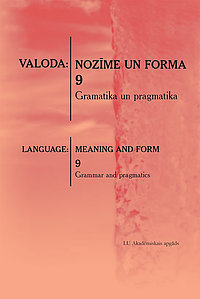Latviešu valodas palatālo eksplozīvo slēdzeņu ķ un ģ akustiskais raksturojums dažādās informantu vecuma grupās (salīdzinājumā ar alveolārajiem afrikatīvajiem slēdzeņiem č un dž)
Acoustic characteristics of the Latvian palatal stops ķ and ģ produced by informants of different age groups (in comparison to the alveolar affricates č and dž)
Author(s): Inese IndričaneSubject(s): Language studies, Foreign languages learning, Phonetics / Phonology
Published by: Latvijas Universitātes Akadēmiskais apgāds
Keywords: Latvian standard language; palatal burst lock; alveolar African lock; acoustic phonetics; acoustic feature; the duration of the noise stage; spectral peak frequency;
Summary/Abstract: The current paper deals with acoustic cues of the prevocalic palatal stops ķ [c] and ģ [ɟ] in the Standard Latvian produced by informants of the four age groups (5–15, 16–39, 40–59, and 60–80). These consonants become a theme of interest, as their correct pronunciation causes difficulties for a quite wide range of speakers, including children those articulatory basis and habits are still in the process of development and thus are more variable in comparison to adults. The new edition of The Latvian Grammar (2013) contains the chapter of orthoepics, where the most important inaccuracies in the pronunciation of the palatal stops ķ [c] and ģ [ɟ], observed for speakers of the High Latvian subdialects and for the Latvian as a foreign language learners (having no such consonants in their subdialect or native language), are discussed. There are still lack of wider studies for speakers’ age impact on the articulation, acoustics, and perception of the Latvian speech sounds. In the current paper the palatal stops ķ [c] and ģ [ɟ] are studied in the phonetic context of the monophthongs i [i], ī [iː], e [e], ē [eː], e [æ], ē [æː], a [ɑ], ā [ɑː], o [ɔ], o [ɔː], u [u], ū [uː]. The analyzed material consists of CVC syllables, e. g. ķiķ [cic], ķīķ [ciːc], ķeķ [cec], ķēķ [ceːc] etc., pronounced by 20 male speakers (5 within each age group). In the framework of this study two acoustic cues of the palatal stops ķ [c] and ģ [ɟ], a duration of release phase and a frequency of spectral peak, are discussed. The results are compared to the data of the alveolar affricates č [ʧ] and dž [ʤ], since the palatal stops ķ [c] and ģ [ɟ] in children’s speech can be mixed or substituted by the alveolar affricate that is similar in its voicing, i. e. ķ [c] by č [ʧ] and ģ [ɟ] by dž [ʤ] (see Markus, Čeirane 2013). The most markable differences are found in the results displayed by the youngest (5 years old) speaker in comparison to older speakers. Further research, more data for children’s speech and the Tests for Statistical Significance are required to be able better distinguish between individual and age related effects.
Journal: Valoda: nozīme un forma
- Issue Year: 2018
- Issue No: 9
- Page Range: 47-67
- Page Count: 21
- Language: Latvian

